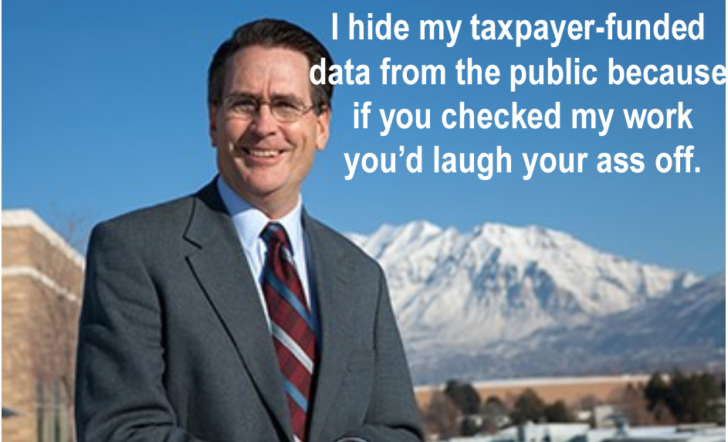Dr. John Dunn taunts Brigham Young University epidemiology junk scientist C. Arden Pope, III.

C. Arden Pope III
Brigham Young University
cap3@byu.edu
Dr. Pope (and many associated ACS CPS II Investigators and Researchers):
Investigators who have conducted, funded, evaluated, and supported epidemiologic research that claims of deaths from fine particulate matter (PM 2.5) and mortality in the 1982 American Cancer Society (ACS) Cancer Prevention Study (CPS II) cohort are warned and put on notice that the the claims made are seriously flawed and based on small associations that are not adequate to prove any of the assertions and claims of lethality. I regret to say that all of those addressed and you, Dr. Pope, know of the epidemiological rules and Bradford Hill Criteria that reject the use of small associations as proof of causation, so any development in research that rejects the deceptions should not be a surprise. You, Dr. Pope, and your colleagues in this enterprise, have been living on borrowed time.
Along with other studies, a new study by Dr. James E. Enstrom to be published in the Spring 2018 issue of JPANDS the Journal of the American Association of Physicians and Surgeons, looks back at fine particle deaths claims made by the addressees and others and debunks the air quality death claims made based on small associations. “Scientific Distortions in Fine Particulate Matter Epidemiology” (http://jpands.org/jpands2301.htm) by Dr. Enstrom, destroys and debunks the claims of studies by researchers exemplified by Dr. Pope, who claims to be the leading air quality epidemiologist in the world.
The problem for you, Dr. Pope and so many others is you claim small associations support projected claims of thousands of deaths annually from fine particles in America, millions around the world. I would assert such claims are nonsense based on a fundamental lie—that small associations prove deaths, when such claims violate basic research rules in epidemiology. Dr. Enstrom’s research is devastating to your claims because he removes even your claims and the claims of your colleagues in this scam of small associations population studies. A satisfactory no evidence study or review showing no evidence in many studies is certainly a proper refutation of claims that have been made based on small no proof associations.
It has been announced recently that the US EPA will no longer base its air quality regulatory policies on the ‘secret science’ opaque data records epidemiology research authored by those addressed here, much of the research associated with CPS II since 1995, and that is a salutary development that rejects previous conduct by the US EPA that assumed and asserted that the small associations claims were legitimate and refused to allow review by other scientists.
It is well known to this writer and to the researchers addressed here that small association based claims do not meet the standards of proof required in observational epidemiological studies, AND IT IS ABOUT TIME TO BE RID OF THIS DECEIT.
Evidence of change in US EPA policy is revealed from the March 19, 2018 Daily Caller “Pruitt Pushes For Transparency In Science” (http://dailycaller.com/2018/03/19/epa-scott-pruitt-secret-science/) and the March 27, 2018 Wall Street Journal “The EPA Cleans Up Its Science” (https://www.epa.gov/newsreleases/wall-street-journal-epa-cleans-its-science).
It is clear that the US EPA will reassess the PM2.5 NAAQS by relying only on transparent and verifiable science and that means small associations will no longer be considered reliable proof of causation. That is reinstituting proper science in public health population studies.
I would suggest your scam is being exposed, your deceptions about small associations will be revealed as violating basic rules of epidemiology and the well funded edifice of small association epidemiology junk science is about to come tumbling down. How unfortunate for you.
Pay attention to these developments—your careers could be at risk, since you have pursued these junk science air quality small associations epidemiology claims so energetically and for so long—how will you explain your misconduct and deceit since even elementary epidemiology condemns the use of small associations as a basis for proof of causation?
Cordially,
John Dale Dunn, MD, JD,
Lecturer Emergency Medicine
Carl R. Darnall Army Medical Center
Member, Editorial Board, JPANDS, the Journal of the American Association of Physicians and Surgeons
jddmdjd@web-access.net
copies to:
James E. Enstrom
Jane Orient
Michael J. Thun
Susan M. Gapstur
W. Ryan Diver
Alpa V. Patel
Daniel Krewski
Michael Jerrett
Richard T. Burnett
Michelle C. Turner
Daniel S. Greenbaum
Aaron J. Cohen
Rashid A. Shaikh
Katherine D. Walker
Maria G. Constantini
Robert OKeefe
Richard F. Celeste
John R. Balmes
Jonathan M. Samet